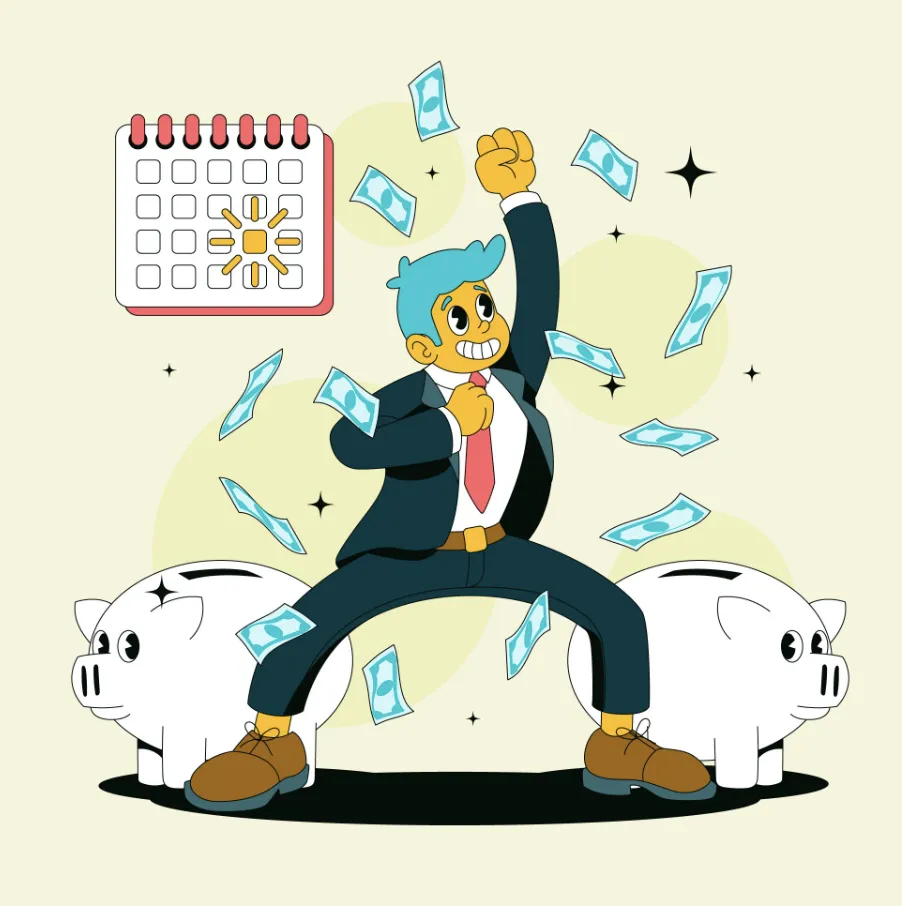Emergency Fund: How Much to Save and Where to Invest
Discover how to calculate your emergency fund, where to invest this money, and practical tips to build your financial security.
Having an emergency fund is like having an umbrella stored in your closet: you hope you'll never need to use it, but when the storm comes, you're glad you prepared. It's that feeling of tranquility that only those who have money saved for unexpected situations know.
If you don't have an emergency fund yet or want to better understand how to structure yours, you've come to the right place. In this article, I'll show you how to calculate the ideal amount, where to invest this money, and practical strategies to accelerate its formation.
Let's dive into this topic that can transform your relationship with money and guarantee much more peace of mind in your daily life.
Table of Contents
- What is an Emergency Fund?
- How to Calculate the Ideal Amount
- The Relationship Between Income and Emergency Fund
- Strategies to Build Your Emergency Fund
- Where to Invest Your Emergency Fund
- How to Use Your Emergency Fund Correctly
What is an Emergency Fund?
An emergency fund is a specific amount of money set aside exclusively for unforeseen situations that could shake your financial stability. Unlike other investments or savings with specific goals, this fund serves as your "financial airbag."
The concept is quite simple: it's that money that stays there, quietly, giving you security to sleep peacefully. You know when you think "what if I lose my job?" or "what if I need emergency surgery?". The fund exists precisely for these situations.
The big difference between this and other investments is that it has no defined timeline for use or specific objective like buying a car or taking a trip. It's literally your financial plan B for when life decides to trip you up.
This amount should be kept in safe and easily accessible investments, allowing immediate withdrawal when necessary. Don't leave it in a drawer losing value to inflation or invest in something risky that might disappear when you need it most.
How to Calculate the Ideal Amount for Your Emergency Fund
Calculating your emergency fund is more art than science, but there are practical guidelines that can help you arrive at a realistic and appropriate amount for your profile.
Step 1: Map Your Essential Expenses
First, you need to know exactly how much you spend per month on expenses that cannot be easily cut. This includes:
- Housing (rent or mortgage)
- Basic utilities (electricity, water, gas, internet)
- Food and groceries
- Transportation
- Health insurance
- Essential medications
- Education (if applicable)
Be brutally honest in this calculation. Also include leisure expenses that you consider essential for your quality of life. After all, the idea is to maintain your standard during a crisis, not become a hermit.
Step 2: Determine the Number of Months
The general rule varies between 3 to 12 months of expenses, depending on your professional stability:
Government employees (3-4 months): Greater job stability and income predictability. The probability of becoming unemployed is lower.
Employees (6-8 months): Moderate stability, but there's always the risk of dismissal or company restructuring.
Self-employed/Freelancers (8-12 months): Variable income and greater instability require more robust protection.
Step 3: Do the Math
Multiply your monthly expenses by the number of months chosen. For example: if you spend $4,000 per month and are an employee, your ideal fund would be $24,000 to $32,000.
Step 4: Add a Safety Margin
The future is unpredictable, so add 10-15% to the calculated value. This margin considers possible expense increases or more complex situations than expected.
The Relationship Between Income and Emergency Fund
Here's a truth many people don't like to hear: your income matters less than your expenses when calculating your emergency fund. It's totally possible that someone earning $5,000 needs a smaller fund than someone earning $8,000.
What really defines the size of your fund is your lifestyle and spending pattern. A person who earns $10,000 but spends $9,500 needs a much larger fund than someone who earns $6,000 and spends $4,000.
The golden rule remains: never spend more than you earn. Ideally, you should be able to save at least 20% of your monthly income. Initially, this money should go directly to forming your emergency fund.
After your fund is complete, that 20% can be directed to more aggressive investments, as suggested by Morgan Housel's "The Psychology of Money" Book, which explains very well the behavioral relationship we have with money.
Practical Strategies to Build Your Emergency Fund
Saving money can be challenging, especially with so many temptations and daily expenses. Here are tested strategies to accelerate your fund formation:
1. Completely Organize Your Finances
Before anything else, you need to know exactly where your money is going. Use spreadsheets, apps, or even a notebook - the important thing is to record everything.
Write down all income (salary, earnings, extra work) and all expenses, including that $5 coffee that seems irrelevant but adds up to $150 at the end of the month.
2. Cut Unnecessary Expenses Without Mercy
After mapping your expenses, you'll be shocked by the amount of money going to useless things. Streaming services you don't use, gym memberships you don't attend, delivery because you're too lazy to cook.
Be rigorous in this cleanup. Every dollar saved here accelerates your fund formation. To learn more about expense control, I recommend reading Cash Flow: What It Is and How to Make - 8 Essential Strategies, which has valuable tips about financial control.
3. Use the 50-30-20 Rule
Divide your income like this:
- 50% for essential fixed expenses
- 30% for variable expenses and leisure
- 20% for investments (initially, your emergency fund)
Remember: if your fixed expenses exceed 50%, take the excess from the 30% variable expenses, not from the 20% investment portion.
4. Create a Separate Account for Your Fund
Open a specific account just for your emergency fund. As soon as you receive your salary, immediately transfer the amount destined for the fund to this account.
This physical separation avoids temptations and makes your goal progress clear. It's the famous "pay yourself first" before any other expense.
5. Take Advantage of All Extra Income
13th salary bonuses, work bonuses, tax refunds, sales of unused objects - all of this should go directly to accelerate your fund. View these extra income sources as boosts to your financial security.
6. Be Rigorous with the Concept of "Emergency"
Your fund is NOT for:
- "Unmissable" promotions
- Trips
- Car changes
- Home renovations
- Paying off existing debts
Emergency is only for real unforeseen events: job loss, health problems, urgent repair of essential equipment.
Where to Invest Your Emergency Fund
Here's the crucial point: your fund needs to yield more than a savings account, but without taking unnecessary risks. The goal isn't to get rich with this money, but to protect it from inflation while maintaining total liquidity.
Fundamental Criteria
Daily Liquidity: You should be able to withdraw the money on the same day or within 2 business days maximum.
Total Security: Zero chance of losing the principal. No stocks, cryptocurrencies, or volatile investments.
Yield Superior to Savings Accounts: Anything that yields more than 70% of the CDI is already better than leaving it in savings.
Best Current Options
Treasury Bills (Short-term Government Bonds): The safest investment in the country. Yields close to the prime rate, has daily liquidity, and risk is practically zero since it's guaranteed by the federal government.
CDs with Daily Liquidity: Digital banks offer CDs that yield between 90% to 110% of the CDI with immediate withdrawal. Check if it has FDIC coverage (up to $250,000).
Money Market Funds: Invest in CDI-linked securities. Have next-day liquidity and profitability close to CDI, minus management fees.
The choice between these options will depend on your bank, available amounts, and personal preference. The important thing is that any of them is infinitely better than traditional savings accounts.
For those looking to expand their knowledge about investment strategies, Thinking, Fast and Slow offers valuable insights on decision-making processes that can help with financial choices.
How to Use Your Emergency Fund Correctly
The moment you hoped would never come has arrived: you need to use your fund. Don't panic - it exists exactly for this.
When to Use It
Use your fund only for genuinely unexpected situations that compromise your financial stability:
- Sudden job loss
- Serious health problems
- Urgent home or car repairs
- Unplanned medical expenses
How to Replenish Quickly
As soon as the situation that caused you to use the fund is resolved, your number 1 priority should be to replenish the withdrawn amount as quickly as possible.
Consider temporarily increasing the percentage you allocate to investments or use any extra income to accelerate this replenishment. Being without a fund is like driving without a seatbelt.
Maintain Discipline
Having used the fund once can create the illusion that it's "normal" to resort to it. Don't fall into this trap. Maintain discipline and use it only for real emergencies.
For those seeking to expand their financial management knowledge, Rich Dad Poor Dad offers valuable insights on developing a healthy financial mindset.
Building Your Financial Security
Having a well-structured emergency fund is the first step to building a solid and peaceful financial life. It's the foundation that allows you to sleep peacefully knowing you're prepared for life's unexpected events.
Remember: it's not about the exact amount you can save, but about creating the habit of protecting yourself financially. Start with what's possible now and gradually increase it.
The feeling of security that a well-formed fund provides is incomparable. It's the difference between living in constant financial stress and having the peace of mind of knowing you're prepared for any situation.
Your emergency fund is much more than saved money - it's an investment in your peace of mind and freedom to make decisions without financial desperation. Start today, even if it's with $50 per month. The important thing is to start.

